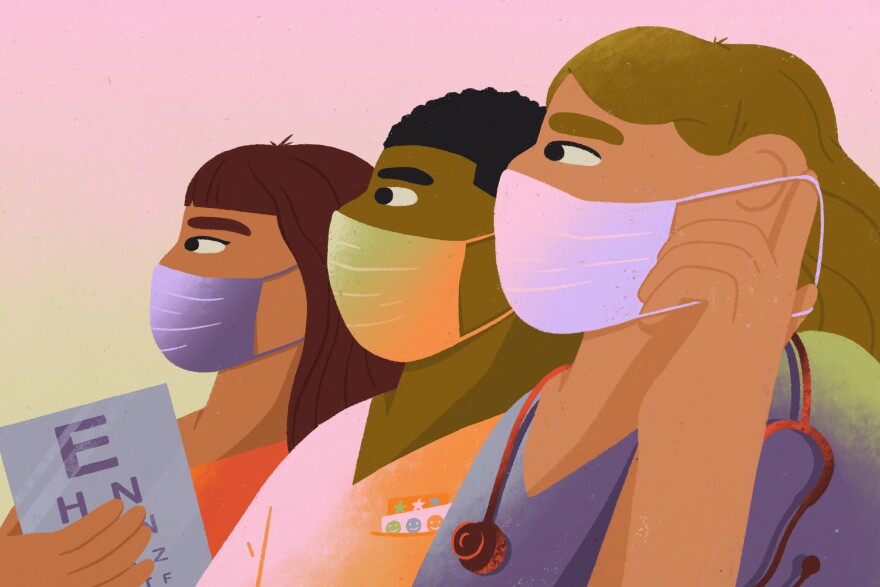In any ordinary school year, school nurses are busy. This year, that's an understatement.
"Our role has expanded tenfold," says Eileen Gavin, who co-leads a team of nurses for Middletown Township Public Schools in New Jersey.
She and school nurses across the country face an unenviable and unprecedented task: caring for students and staff during a global pandemic. "We were at the front line of COVID-19 before the stay at home orders were put into place," says Gloria Barrera, the president-elect of the Illinois Association of School Nurses. They'll be at the front line again, she says, as the school year begins.
Many nurses, including Gavin and Barrera, have been working with their school districts over the summer to prepare plans for every scenario imaginable. But they say that's not the case for everyone.
"I know a lot of nurses have asked to be at the table and they're not being invited or disregarded," Gavin says. "And honestly, would you want your child to return to a school where a school nurse was not part of the plan?"
Colleen, who leads a team of school nurses in Texas, wishes she had more of a voice in her district's decisions for the coming year.
"Overwhelmingly, the response has been, well, let us get some decisions made," she says. "And then once the big decisions are made, you and your nurses can implement plans around that." That means she wasn't at the table to relay the most recent research about social distancing or disease spread to district leaders drafting a re–opening plan. (We're using Colleen's middle name so she can speak freely about her employer.)
Back in April, when many schools closed their doors, the National Association of School Nurses (NASN) polled members around the country about their roles in pandemic plans. "While about 60 percent of those school nurses were part of the conversation with their school teams...around COVID, about 40 percent of school nurses weren't involved in the conversation," says Donna Mazyck, executive director of NASN.
In many places, nurses aren't part of the conversation because they simply don't exist. According to data from NASN, only about half of all schools employ a full time nurse. And, says Mazyck, "Twenty–five percent of schools do not have a school nurse at all."
In Gavin's New Jersey district, they're recruiting for more school nurses and substitute nurses. "And unfortunately, that seems to be a problem because of the pay," she says. School nurses with experience and advanced degrees can often make more money at hospitals, which desperately need them too.
Even in districts starting the year with mostly virtual learning, nurses plan to hold telehealth visits and check in on students with chronic illness. Gavin, whose school district is finalizing plans for a hybrid model with in-person and virtual options, says she and her nursing team are trained COVID-19 contact tracers.
They'll also be checking on students traumatized by the pandemic. There's "uncertainty, grief and fear that's come because of COVID-19," says Mazyck. "[Students] will have family members who passed away. They will have acquaintances who no longer have grandparents in their home," she says. They will need support from trusted adults at school — often, support they seek from their school nurses.
For schools intending on a return to in-person classes this fall, nurses must consider seemingly-endless numbers of safety measures: creating social distancing and masking protocols. Asking students to bring water bottles instead of using water fountains. Designating one-way hallways to decrease traffic between classes. Creating a separate "sick" area for students and staff who have symptoms. Staffing that area. Establishing protocol for contact tracing. Planning for new outbreaks.
"I feel as though it's a rabbit hole. Once I go down the hole, I think I solved something? There's another issue with that. So we go down that hole. It seems endless," Gavin says.
She says she's thinking about every possibility — like replacing her school's stock of nasal Narcan, a treatment for opioid overdoses, with the injectable version in order to decrease risk of spreading the virus. In a district outside Columbia, South Carolina, health services coordinator Dawn MacAdams is thinking about kids with asthma. "We are going to ask that our parents work with their physicians to only bring in an inhaler, not a nebulizer," she says. That's because nebulizers generate aerosol, and there's a chance that tiny virus particles in that aerosol could spread COVID-19.
But no amount of planning can answer the questions even infectious disease experts don't know about COVID-19.
The rate that kids transmit the coronavirus remains unclear. "We don't know what the impact is going to be, putting those children with faculty and staff," says MacAdams. "We don't know what disease spread is reallygoing to look like when we put everyone back into the petri dish of a school setting."
That's one reason why MacAdams, who just wrapped her term as president of the South Carolina Association of School Nurses, co-wrote a letter to South Carolina Gov. Henry McMaster after he pushed for schools to include in-person options at the start of the school year. "The reality is that most South Carolina schools are not currently prepared to reopen during this pandemic," they wrote, pushing for state leaders to allow districts to follow health guidelines in the re-opening process.
MacAdams feels lucky to have a voice in her district's reopening plans, and she and others who do are advocating for nurses across the country to have a say in what happens where they live.
They're also pressing for more funding, which school nurses overwhelmingly say their districts need to re–open safely. "I mean, the amount of masks, cloth masks, regular face masks, face shields, gowns, gloves...hand sanitizer, hand soap, cleaning supplies — it's very overwhelming when you think of the cost," says MacAdams.
In New Jersey, Eileen Gavin says she's spent sleepless nights worrying about what the new school year might bring.
"I do feel the weight of the world and the weight of my community as we return to school, that we're doing everything right...that there was nothing else that we could have done," she says. "We care about every one of those kids and every staff member."
But she still feels lucky to be a part of those big plans in her district. "It is an enormous role that school nurses have right now" she says. "It's a lot of responsibility, but it's even worse if you don't have a voice."
Copyright 2020 NPR. To see more, visit https://www.npr.org. 9(MDAwMzY5MzE4MDEzMTE3ODg5NDA4ZjRiNg004))



